
April 2006 Visit to Arizona-Sonora Desert Museum
& Grant's Pass
Kitty and Paul Antonik Wakfer enjoy occasional excursions to the Arizona Sonora Desert Museum (ASDM) west of Tucson and consider it a good introduction for visitors from elsewhere to a large amount of the flora and fauna of this region. We'd made our last visit by ourselves in early January, purposely early enough to see the free raptor flight at 1:00pm because when we'd taken the Snirs in 2005, we'd been too late to see all of it or hear any of the docent explanations. Taking Oli (Olafur Pall Olafsson) during his visit from Iceland just seemed a natural thing to do. By Thursday April 6, we'd had several days of slow paced activity after a weekend of hiking, first in Sedona and then at the Grand Canyon.
The raptors (birds of prey) seen flying below are 4 Harris Hawks, a family lead by a dominant female. The docent explained during the course of the "exhibition" that these birds stay in the area because they find or are fed food here regularly. On occasion one will fly off for a few hours but all have returned within a day. They are kept in an area off the main museum grounds in between free flight demonstrations and then are fed specially raised mice. This was the same group of birds that we'd seen in January, and we were told that the earlier demonstration at 10am contained other types of birds. We'll try for that one next Winter.

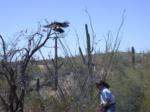
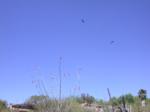

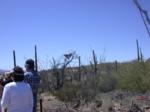
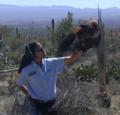
It was going on towards 2:00pm by the time we moved away from the area where the raptor free flights take place, so we didn't have a great deal of time before the grounds close at 4:00. While we saw almost everything, Kitty kept her picture taking to a minimum.
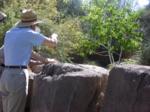
Paul answered the question of a stranger as to where was the deer, by pointing it out in the corner of the semi-cave. 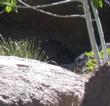
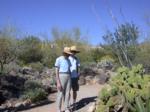
Paul notes to Oli that this particular cactus is a very common variety of prickly pear, one of those that we have in our yard in Casa Grande. The young pads (nopalitos) are good to eat - once the fine needles are removed. And the flowers on this family of cactus in May and June are really delightful. When the subsequent fruit ripen, they can be used to make jellies or syrup. 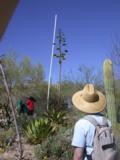
Oli was entranced by the giant flower stalk of a century plant agave. The white measuring pole was marked on the other side; it's advance upward began the past October - 6 months earlier. Once the flower blooms the plant will begin to die. Several plants in various stages of decay - still upright or fallen over - with dried flowers and stalk in place can be seen throughout the ASDM grounds. Part of one is visible in the foreground left.
After we had seen all that we could in the short time before the ASDM closed at 4pm, we drove eastward and upward into Gate's Pass, stopping to take in the spectacular views in all directions.
 Oli almost immediately started to climb the nearest peak, taking a pause here to decide which route would be best.
Oli almost immediately started to climb the nearest peak, taking a pause here to decide which route would be best.
Paul and Kitty in the meantime hiked up to a lower peak, taking a route different from the one they used in January. Paul struck a pose here above Kitty on the immediate local maximum.
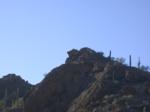
Oli appeared 3 minutes later; his head can be seen on the near peak below the red arrow.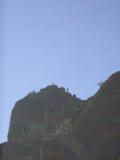


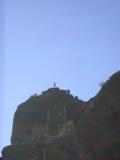
Kitty and Paul expected that Oli would descend from the nearby peak but after a few minutes we looked at the further peak. There he was on the very top. He spent some time absorbing the views from different angles before making his way down and by yet another route, one we couldn't see from our position.
When Oli did reach us, he told us of how on his way down he'd taken what he thought was the same path. Unfortunately, he soon found himself surrounded with cactuses, unable to see us, though still able to see the Tucson area. As he recently put in writing, "I swear no matter what direction I looked everything looked the same. There were just cactuses, sand, rocks, cactuses on sand, cactuses with sand on it, even more cactuses." Using the sun and the view of Tucson he determined which way to go to get back to the area of the parking lot. However, shortly before reaching Kitty and Paul, Oli walked too close to a cholla cactus and the small barbs of the easily disturbed small pieces lodged in his calf. (This is a chief mechanism by which the plant reproduces; roots will sprout when the small pieces have broken off onto the ground.) He remembered Kitty telling him that if this happened he should not try to pick it off with his fingers. He successfully removed it with a couple of rocks. All together this was a full experience of desert hiking in a very short time.
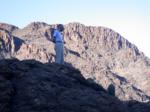 The numerous saguaros can be seen on the mountainside in the distance as Paul takes in the view of Tucson. The city can be seen pretty well from this point but even better from either of the two peaks where Oli had hiked. We may try them next winter.
The numerous saguaros can be seen on the mountainside in the distance as Paul takes in the view of Tucson. The city can be seen pretty well from this point but even better from either of the two peaks where Oli had hiked. We may try them next winter.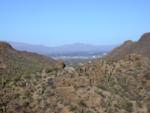
This is the view of Tucson that Paul and Kitty could see from their position. The major portion of the city is ringed with mountains, housing saguaros like those seen here which appear to actually look down on the city itself.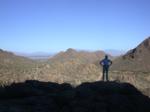
Shadows from the nearby peak stretch over Paul, while Tucson catches the late afternoon sun.
We continued through Grant's Pass and picked up I-10 for our drive back north to Casa Grande. It was not too many years ago that this highway was on the western edge of Tucson itself. Now the city limits extend almost to Grant's Pass in the west and part way up the mountains on the that arc over much of the north and east. The south is wide open with no geographical limits to growth.
MoreLife is Always "Under Construction"
Initially posted 9/6/06
Page last updated 9/6/06
Any questions, comments or suggestions regarding the content of this website
should be addressed at MoreLife Yahoo.
For comments on webpage format, contact Kitty
Antonik Wakfer























